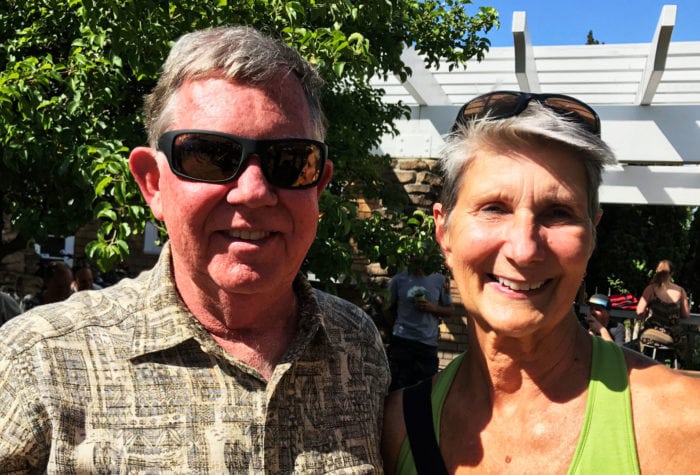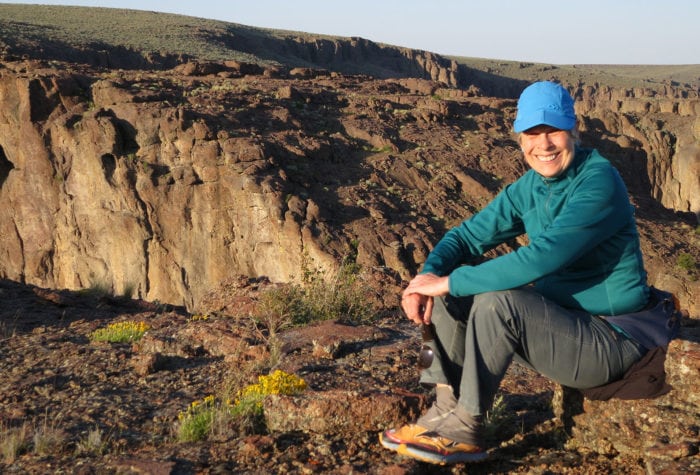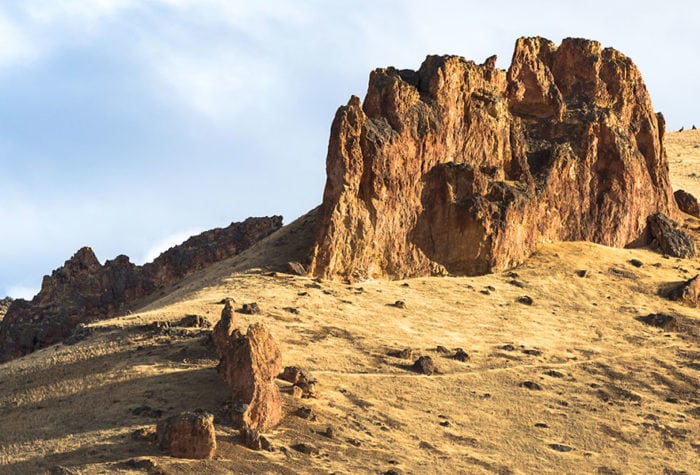Author: Hana Sant | Published: April 5, 2021 | Category: Profile
ONDA’s members come to us from a wide range of backgrounds, each with a unique path that has led them to an enduring love of Oregon’s desert.
Here, we’re highlighting four members whose work in the sciences has proved to be a source of inspiration and motivation to support ONDA’s mission.
Carol Savonen: Field biologist, writer and chapter starter
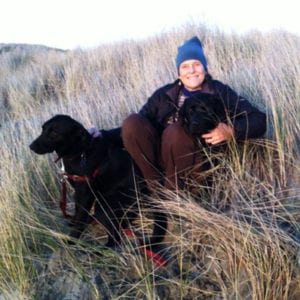
A seasonal position at Malheur National Wildlife Refuge was the launching point for Carol Savonen’s long career in biological sciences, which would eventually carry her throughout the Pacific Northwest and include stints at various federal agencies.
For 20 years, she worked at Oregon State University as a science writer, covering the research projects of OSU instructors and students. A field biologist at heart, each summer she would take off to conduct botanical surveys, go on natural history trips on assignment from National Geographic, and take part in any kind of field work she could.
At 55, Carol retired and turned her attention to conservation work. She started the first Oregon chapter of Great Old Broads for Wilderness in 2010. Searching for volunteer opportunities for the new chapter led her to ONDA. Carol loves the citizen science component of ONDA’s work and just registered to be an Independent Steward.
Why Carol supports ONDA’s mission: Carol has always been in love with eastern Oregon. She remembers working out of Malheur in the 1970s and how damaged the ecosystems on Steens and Hart Mountain were and finds hope in how well they’ve recovered since then. She believes in the impact our volunteers are making in these treasured landscapes.
Her hope: “I hope that increased conservation and recreation makes people more aware of what we have to lose and what we need to protect. People used to consider eastern Oregon a wasteland, and now more and more people know how special it is.”
Timothy Babalis: Environmental historian
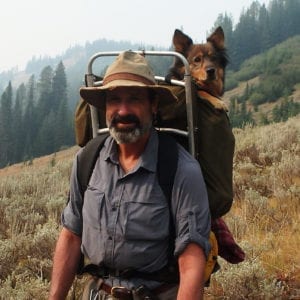
The desert has always felt like home for Timothy Babalis, who has volunteered for restoration efforts in the deserts of both California and Oregon for decades.
Early in his career, Timothy volunteered for the National Park Service and held seasonal positions in natural resource restoration work. After earning a PhD, Timothy became an environmental historian for the National Park Service. His work focuses on humans in the landscape, how the environment has changed, and how humans have influenced those changes over time. After documenting the destruction of environmental quality since white colonizers came to North America, he is interested in “restoring that damage and learning how to live in a more sustainable and positive way with the natural world.”
In 2011, Timothy and his wife moved from California to Portland, Oregon. He had always spent time recreating and doing restoration work in California deserts, so when he arrived in Oregon he set out looking for volunteer opportunities in Oregon’s desert – which led him to ONDA. Timothy appreciates that ONDA integrates stewardship goals with advocacy and gets volunteers out into the landscape. He’s been impressed and inspired by the stewardship coordinators he has encountered, and has been a stalwart volunteer.
What inspires Timothy to support ONDA: Timothy’s passion for restoration, and ONDA’s work to restore desert landscapes coupled with our advocacy efforts, motivate his support. He also appreciates ONDA’s work to engage with Native American tribes and feels this work is important and exciting in the context of conservation, as we can all learn from those who have lived on these lands the longest how to care for and positively impact the natural world.
His hope: “Restoration and other conservation activities are a process … My greatest hope would be that we reach an understanding that continuously conserving and restoring the natural world is a way of life we need to adopt for the long term, rather than an end goal we achieve.”
Monica Tomosy: Experienced federal agency leader
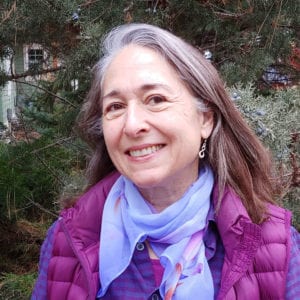
As a child, Monica Tomosy always wanted to be outside – playing in treehouses, holding funerals for dead birds. Her parents nurtured her fascination, always pointing out natural features that were marvelous, curious and beautiful. Monica’s connection to nature fueled her passion for conserving it, and ultimately led her to a career in the natural sciences.
For 33 years she worked for federal agencies in Washington, D.C., including a position as a program manager for the wildlife research program at the United States Forest Service where one of her focuses was in sagebrush ecosystem restoration and conservation. She served on the pollinator task force during the Obama administration, which included native plant development and habitat restoration. Climate change adaptation became another significant focus of her career and she was a liaison to the United States Geological Survey Climate Center. Monica has also worked extensively with endangered birds and has a professional interest in bird conservation.
One of Monica’s first work experiences was as an intern for the Student Conservation Association in southwest Oregon in the 80s, and her first visit to eastern Oregon took her breath away. While working in D.C., knowing that places like eastern Oregon still exist gave her hope, and she and her husband always planned to retire here and do their part to ensure protections for this remarkable region. Monica volunteers with a variety of conservation organizations, and recently joined ONDA’s board of directors. We are lucky to have her passion and experience helping guide our work.
Why Monica is an ONDA member: “It is a critical time to get back on track to protect and restore sagebrush ecosystems. I am looking forward to learning a lot from other people in ONDA’s community. I know I come at it with a set of experiences, knowledge, and interests but I know I’ll be interacting with people who have their own and I’m looking forward to learning new insights and new awareness of thinking about things in ways I haven’t thought about them before. It’s exciting!”
Her hope: “In the long term, my greatest hope is to restore functional sagebrush ecosystems in this northwestern portion of the Great Basin biome. I think we can achieve that if more people valued the unique biological diversity of the sagebrush-steppe landscape, versus viewing it as something that must be modified or used up. I’ve traveled to other parts of the world and parts of our country, where communities realize they can have long term sustainable income if they protect an area and attract people to come spend time in it through no or low-impact activities rather than activities that degrade nature with shorter-term benefits. We can look to a variety of models of communities that are both ecologically and economically sustainable. Also, a lot of progress has been made on how to restore native plant communities in the Great Basin. It could happen here in Oregon.”
Todd Hanna: Fisheries Technologies Instructor
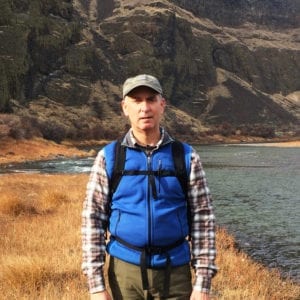
A fisheries instructor in the Fisheries Technology program at Mt. Hood Community College, Todd Hanna is passionate about stream restoration – in particular desert stream restoration. To help prepare his students to begin their fisheries careers, he keeps his course curricula updated with current science and techniques and has, in recent years, focused his attention on beaver-related desert stream restoration. Living in The Dalles, he frequents Cottonwood Canyon State Park, and his love of the high desert motivates him to support restoration efforts in the region.
Todd first learned about ONDA while scouring the internet for ways to volunteer in the high desert. “Once I found the organization, I volunteered for my first stewardship trip and was hooked,” he said Attending the annual meeting at the Hancock Field Station solidified his interest in supporting and working with ONDA.
Todd has worked extensively with Jefferson Jacobs, our resident beaver-related restoration expert, on designing a sampling and monitoring project designed to fill knowledge gaps around the use of beaver dam analogues (BDAs). “While the primary goal for these trips is to gather important data and teach students the techniques needed to do that,” Todd explained, “I also hope to spark some interest in high desert conservation in my students so they will become good stewards of high desert resources in the future.” Several years ago, he took a group of students out to help with riparian planting on a small steelhead spawning tributary stream in the Malheur National Forest. The students on that stewardship trip became very interested in the high desert and ONDA’s mission, and many became ONDA members.
Why Todd joined our desert conservation community: “I really believe in ONDA’s mission. I’ve been able to meet and work with some very dedicated staff members and volunteers committed to protecting the high desert for future generations. Some of the nicest people I’ve met since moving to Oregon over 20 years ago have been on ONDA stewardship trips. Every time I get a chance to spend time in the high desert, I realize what a unique and special, but also fragile, area it is. Those experiences motivate me even more to get involved and do what I can to protect and restore what we have in the high desert.”
His hope: “My greatest hope is that people will continue to become aware of how special and fragile the high desert is and that they will take action to help protect and conserve those areas that still don’t have permanent protection, like the Owyhee Canyonlands. I also hope people will decide to volunteer some of their time and expertise to help restore areas that have been damaged by past land-use practices. Being a fisheries biologist, I am particularly excited about the River Democracy Act championed by Senator Wyden. Passage of this bill would go a long way towards protecting these extremely valuable resources in the high desert.”
